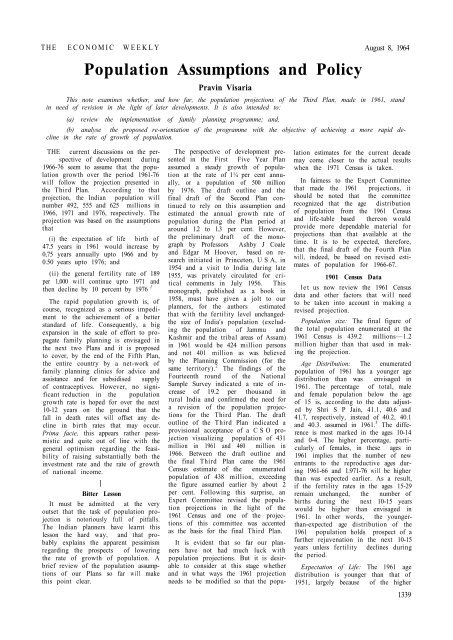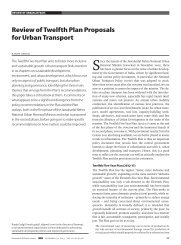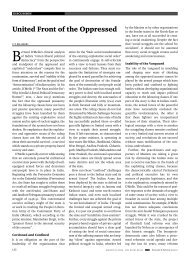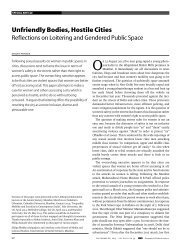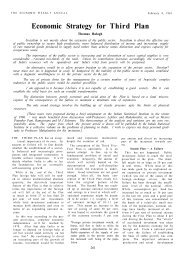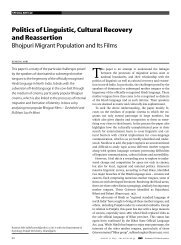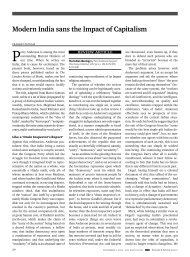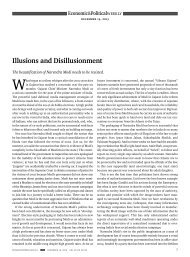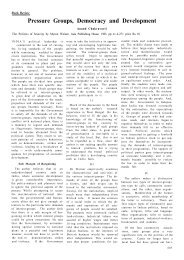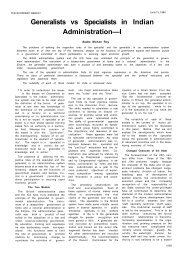Download PDF version - Economic and Political Weekly
Download PDF version - Economic and Political Weekly
Download PDF version - Economic and Political Weekly
You also want an ePaper? Increase the reach of your titles
YUMPU automatically turns print PDFs into web optimized ePapers that Google loves.
THE ECONOMIC WEEKLY August 8, 1964<br />
Population Assumptions <strong>and</strong> Policy<br />
Pravin Visaria<br />
This note examines whether, <strong>and</strong> how far, the population projections of the Third Plan, made in 1961, st<strong>and</strong><br />
in need of revision in the light of later developments. It is also intended to:<br />
(a) review the implementation of family planning programme; <strong>and</strong>,<br />
(b) analyse the proposed re-orientation of the programme with the objective of achieving a more rapid decline<br />
in the rate of growth of population.<br />
THE current discussions on the perspective<br />
of development during<br />
1966-76 seem to assume that the population<br />
growth over the period 1961-76<br />
will follow the projection presented in<br />
the Third Plan. According to that<br />
projection, the Indian population will<br />
number 492, 555 <strong>and</strong> 625 millions in<br />
1966, 1971 <strong>and</strong> 1976, respectively. The<br />
projection was based on the assumptions<br />
that<br />
(i) the expectation of life birth of<br />
47.5 years in 1961 would increase by<br />
0,75 years annually upto 1966 <strong>and</strong> by<br />
0.50 years upto 1976; <strong>and</strong><br />
(ii) the general fertility rate of 189<br />
per 1,000 will continue upto 1971 <strong>and</strong><br />
then decline by 10 percent by 1976 1<br />
The rapid population growth is, of<br />
course, recognized as a serious impediment<br />
to the achievement of a better<br />
st<strong>and</strong>ard of life. Consequently, a big<br />
expansion in the scale of effort to propagate<br />
family planning is envisaged in<br />
the next two Plans <strong>and</strong> it is proposed<br />
to cover, by the end of the Fifth Plan,<br />
the entire country by a net-work of<br />
family planning clinics for advice <strong>and</strong><br />
assistance <strong>and</strong> for subsidised supply<br />
of contraceptives. However, no significant<br />
reduction in the population<br />
growth rate is hoped for over the next<br />
10-12 years on the ground that the<br />
fall in death rates will offset any decline<br />
in birth rates that may occur.<br />
Prima facie, this appears rather pessimistic<br />
<strong>and</strong> quite out of line with the<br />
general optimism regarding the feasibility<br />
of raising substantially both the<br />
investment rate <strong>and</strong> the rate of growth<br />
of national income.<br />
I<br />
Bitter Lesson<br />
It must be admitted at the very<br />
outset that the task of population projection<br />
is notoriously full of pitfalls.<br />
The Indian planners have learnt this<br />
lesson the hard way, <strong>and</strong> that probably<br />
explains the apparent pessimism<br />
regarding the prospects of lowering<br />
the rate of growth of population. A<br />
brief review of the population assumptions<br />
of our Plans so far will make<br />
this point clear.<br />
The perspective of development presented<br />
in the First Five Year Plan<br />
assumed a steady growth of population<br />
at the rate of 1¼ per cent annually,<br />
or a population of 500 million<br />
by 1976. The draft outline <strong>and</strong> the<br />
final draft of the Second Plan continued<br />
to rely on this assumption <strong>and</strong><br />
estimated the annual growth rate of<br />
population during the Plan period at<br />
around 1.2 to 1.3 per cent. However,<br />
the preliminary draft of the monograph<br />
by Professors Ashby J Coale<br />
<strong>and</strong> Edgar M Hoover, based on research<br />
initiated in Princeton, U S A, in<br />
1954 <strong>and</strong> a visit to India during late<br />
1955, was privately circulated for critical<br />
comments in July 1956. This<br />
monograph, published as a book in<br />
1958, must have given a jolt to our<br />
planners, for the authors estimated<br />
that with the fertility level unchangedthe<br />
size of India's population (excluding<br />
the population of Jammu <strong>and</strong><br />
Kashmir <strong>and</strong> the tribal areas of Assam)<br />
in 1961 would be 424 million persons<br />
<strong>and</strong> not 401 million as was believed<br />
by the Planning Commission (for the<br />
same territory). 2 The findings of the<br />
Fourteenth round of the National<br />
Sample Survey indicated a rate of increase<br />
of 19.2 per thous<strong>and</strong> in<br />
rural India <strong>and</strong> confirmed the need for<br />
a revision of the population projections<br />
for the Third Plan. The draft<br />
outline of the Third Plan indicated a<br />
provisional acceptance of a C S O projection<br />
visualizing population of 431<br />
million in 1961 <strong>and</strong> 460 million in<br />
1966. Between the draft outline <strong>and</strong><br />
the final Third Plan came the 1961<br />
Census estimate of the enumerated<br />
population of 438 million, exceeding<br />
the figure assumed earlier by about 2<br />
per cent. Following this surprise, an<br />
Expert Committee revised the population<br />
projections in the light of the<br />
1961 Census <strong>and</strong> one of the projections<br />
of this committee was accented<br />
as the basis for the final Third Plan.<br />
It is evident that so far our planners<br />
have not had much luck with<br />
population projections. But it is desirable<br />
to consider at this stage whether<br />
<strong>and</strong> in what ways the 1961 projection<br />
needs to be modified so that the population<br />
estimates for the current decade<br />
may come closer to the actual results<br />
when the 1971 Census is taken.<br />
In fairness to the Expert Committee<br />
that made the 1961 projections, it<br />
should be noted that the committee<br />
recognized that the age distribution<br />
of population from the 1961 Census<br />
<strong>and</strong> life-table based thereon would<br />
provide more dependable material for<br />
projections than that available at the<br />
time. It is to be expected, therefore,<br />
that the final draft of the Fourth Plan<br />
will, indeed, be based on revised estimates<br />
of population for 1966-67.<br />
1901 Census Data<br />
let us now review the 1961 Census<br />
data <strong>and</strong> other factors that will need<br />
to be taken into account in making a<br />
revised projection.<br />
Population size: The final figure of<br />
the total population enumerated at the<br />
1961 Census is 439.2 millions—1.2<br />
million higher than that used in making<br />
the projection.<br />
Age Distribution: The enumerated<br />
population of 1961 has a younger age<br />
distribution than was envisaged in<br />
1961. The percentage of total, male<br />
<strong>and</strong> female population below the age<br />
of 15 is, according to the data adjusted<br />
by Shri S P Jain, 41.1, 40.6 <strong>and</strong><br />
41.7, respectively, instead of 40.2, 40.1<br />
<strong>and</strong> 40.3. assumed in 1961. 3 The difference<br />
is most marked in the ages 10-14<br />
<strong>and</strong> 0-4. The higher percentage, particularly<br />
of females, in these ages in<br />
1961 implies that the number of new<br />
entrants to the reproductive ages during<br />
1961-66 <strong>and</strong> 1.971-76 will be higher<br />
than was expected earlier. As a result,<br />
if the fertility rates in the ages 15-29<br />
remain unchanged, the number of<br />
births during the next 10-15 years<br />
would be higher than envisaged in<br />
1961. In other words, the youngerthan-expected<br />
age distribution of the<br />
1961 population holds prospect of a<br />
further rejuvenation in the next 10-15<br />
years unless fertility declines during<br />
the period.<br />
Expectation of Life: The 1961 age<br />
distribution is younger than that of<br />
1951, largely because of the higher<br />
1339
THE ECONOMIC WEEKLY August 8, 1964<br />
growth rate during the decade. The<br />
other possible factor of a better coverage<br />
of the young population <strong>and</strong>/or<br />
better age reporting than in 1951 is<br />
difficult to evaluate in quantitative<br />
terms. The higher growth rate itself<br />
seems to be due to the rapid decline<br />
in mortality during the last 10-15<br />
years. According to the life-tables prepared<br />
by the Census actuary on the<br />
basis of the 1961 data, the expectation<br />
of life during 1951-60 was 41.2 years<br />
for both sexes together, 41.9 years for<br />
males <strong>and</strong> 40.6 for females. 4 The corresponding<br />
estimates for 1941-50 were<br />
32.1 years for both sexes, 32.4 for<br />
males <strong>and</strong> 31.7 years for females. The<br />
reference dates of these estimates are<br />
usually taken to be the mid-points of<br />
respective decades.<br />
Expectation of Life<br />
Thus the expectation of life for both<br />
sexes has increased during 1946-55 at<br />
an annual average rate of 0.9 years,<br />
although the gap between males <strong>and</strong><br />
females with respect to the expectant<br />
life-time, adverse to the fair sex, has<br />
increased. If the same rate of improvement<br />
were to continue, the expectation<br />
of life at the start of 1961, for both<br />
sexes together, would be estimated at<br />
about 45.8 years. Interestingly enough,<br />
an application of the quasi-stable population<br />
model to the 1961 age distribution<br />
has given an estimate of 44.96<br />
years as the expectation of life for<br />
both sexes during the year ending<br />
March 31, 1961. 5 The difference between<br />
these two figures <strong>and</strong> that assumed<br />
in the projection accepted for 'he<br />
Third Plan (47.5 years) is not very<br />
large in absolute terms. But to move<br />
from an expectation of life of 41.2<br />
years at the start of 1956 to 47.5<br />
years in 1961 would imply an average<br />
annual increase of 1.2 years. This rate<br />
is certainly not impossible. In fact,<br />
same acceleration in the rate of improvement<br />
in the expectation of life<br />
during the Second Five Year Plan<br />
appears quite reasonable. However, if<br />
this rate is taken to be 1.2 years per<br />
annum during 1956-60, one would probably<br />
expect a correspondingly higher<br />
rate of improvement in the expectalion<br />
of life over the period 1961-76<br />
Alternatively, the estimated expectation<br />
of life in 1961 may be assumec<br />
to be somewhat lower than 47.5 years.<br />
In our opinion, the latter alternative<br />
seems to be more reasonable.<br />
In any case, for purposes of the<br />
projection, the initial expectation of<br />
life is less important than the rate at<br />
which it will improve. It. is generally<br />
argued, <strong>and</strong> with some plausibility, no<br />
doubt, that once the gains in expectation<br />
from malaria eradication <strong>and</strong><br />
similar programmes are realised, the<br />
future improvements will depend on a<br />
general rise in the st<strong>and</strong>ards of living<br />
<strong>and</strong> will be relatively more difficult<br />
to attain. This is the rationale behind<br />
the 1961 assumption that the rise in<br />
the expectation will be slow during<br />
1961-66 compared to that curing<br />
1956-61 <strong>and</strong> slower still during 1966-<br />
76. There is reason to believe, however,<br />
that if the substantial investments<br />
in rural <strong>and</strong> urban water supply<br />
<strong>and</strong> sanitation prove effective, that<br />
will have a significant impact on both<br />
morbidity <strong>and</strong> mortality. One hopes<br />
that until our vital statistics attain a<br />
certain degree of comprehensiveness,<br />
we shall keep ourselves informed of<br />
the rate of progress through periodical<br />
sample surveys so that we are not<br />
once again taken by surprise as in<br />
1958-59.<br />
Fertility: Fertility is, of course, a<br />
key variable in population projection.<br />
And the family planning programme,<br />
to be discussed in the next section, is<br />
no doubt geared to the goal of reducing<br />
level of fertility. But the birth rate<br />
of 41.7. estimated by Shri S P Jain for<br />
the decade 1951-60, implies a slightly<br />
higher level of fertility, that was as<br />
sumed in 1961. The assumed general<br />
fertility rate of .189 seems low by<br />
about 3 per cent. The difference between<br />
the more recent figure <strong>and</strong> that<br />
assumed in 1961 is thus relatively<br />
small but it will nevertheless need to<br />
be taken into account.<br />
Immigration: One of the factors responsible<br />
for the excess of the 1961<br />
Census estimate of the enumerated<br />
population over the earlier projections<br />
might be that the projections were all<br />
based on the assumption of nil net<br />
international migration. Actually, the<br />
data on religion suggest a considerable<br />
immigration into India during 1951-61<br />
of both Hindus <strong>and</strong> Muslims from<br />
East Pakistan. As the events of the<br />
past few months have shown, such<br />
immigration is not a matter of the<br />
past, at least so far as the Hindus in<br />
East Pakistan are concerned. Similarly,<br />
Indians returning from Burma after<br />
1961 will also form a not insignificant<br />
number. While as a percentage of the<br />
total population of India, the number<br />
of net immigrants may be small, it<br />
should be taken into account while<br />
revising the population projections.<br />
It is not possible here to make a<br />
quantitative estimate of the extent by<br />
which the factors mentioned above<br />
will alter the estimates of population<br />
for 1961-76; but it should be evident<br />
that the estimates are likely to be<br />
raised upwards. In effect, unless the<br />
fertility level declines, population<br />
growth is likely to constitute an even<br />
more serious threat to our targets of<br />
per capita income/consumption than<br />
has been the case so far.<br />
II<br />
Population Policy during the Plans<br />
The above conclusion logically leads<br />
to a discussion of population policy.<br />
It is well-known that promotion of<br />
voluntary family limitation has been<br />
an accepted state policy ever since<br />
1952 when the First Plan was published.<br />
The proposed outlay on the<br />
programme has increased from Rs 50<br />
lakhs in the First Plan to Rs 5 crores<br />
during the Second Plan <strong>and</strong> Rs 27<br />
crores (with a ceiling of Rs 50 crores)<br />
during the Third Plan. The actual expenditure<br />
has been less than the proposed<br />
outlay—Rs 16 lakhs during the<br />
First Plan <strong>and</strong> Rs 2.29 crores during<br />
the Second Plan. The expenditure during<br />
the first two years of the Third<br />
Plan <strong>and</strong> the budget provision for<br />
1963-64 together add up to only Rs 7<br />
crores—a little over one-fourth of the<br />
total outlay. 6 Of course, the evaluation<br />
of a programme on the basis of<br />
expenditure is in some ways misleading.<br />
But it shows that the paucity of<br />
funds has not obstructed the success<br />
of the family planning programme.<br />
The main emphasis of the programme<br />
has been on family planning<br />
clinics. In the Third Plan, voluntary<br />
sterilization was also accepted as having<br />
a valuable contribution to make<br />
to the programme. At the end of the<br />
Second Plan, the number of clinics<br />
was 1,379 in rural areas <strong>and</strong> 757 in<br />
urban areas. The Third Plan proposed<br />
the target of a total of 6,100 rural<br />
<strong>and</strong> 2,100 urban clinics. At the end<br />
of 1962-63, however, the actual number<br />
of clinics was 2,039 in rural <strong>and</strong> 966<br />
in urban areas or a total of 3,005. The<br />
number of reported sterilizations during<br />
1956-1962 was nearly 3.75 lakhs, nearly<br />
three-fourths of which were vasectomies<br />
on males. 7<br />
However, the pace of progress has<br />
been too slow to make any impact on<br />
the birth rate, except probably in<br />
Madras State where the birth rate<br />
during 1951-60 has been estimated at<br />
35 per 1000, Various surveys on attitudes<br />
to family planning, both in rural<br />
<strong>and</strong> urban areas, have reported a very<br />
large proportion of the population to<br />
be willing to learn about <strong>and</strong> practice<br />
family limitation. But the verbal res-<br />
1341
August 8, 1964<br />
ponses do not really indicate the willingness<br />
to act <strong>and</strong> the readiness to use<br />
regularly the rhythm method or other<br />
contraceptives has been found to be<br />
weak. The one case in which the birth<br />
rate of a population exposed to an intensive<br />
programme of promoting family<br />
limitation has shown any decline during<br />
the tenure of the study has been<br />
an experimental area around Singur<br />
Health Centre near Calcutta. There,<br />
in a rural population of about 8,000<br />
the birth rate declined, between 1956-<br />
61, by 18 per cent over the initial<br />
value of 45 per 1,000 population <strong>and</strong><br />
by 14 per cent when compared to the<br />
1961 birth rate in the control population.<br />
8<br />
THE ECONOMIC WEEKLY<br />
Revision of the Programme<br />
More recently, the entire family<br />
planning programme is being reoriented.<br />
The 1962-63 report of the<br />
Director of Family Planning has proposed<br />
that the main goal of the programme<br />
should be "to accelerate the<br />
rate of adoption of family planning so<br />
as to reduce the birth rate in India<br />
1342
THE ECONOMIC WEEKLY August 8, 1964<br />
to 25 births per 1,000 population by<br />
1973." To achieve this laudable objective<br />
of lowering the birth rate by 40<br />
per cent over a decade, the programme<br />
will undertake two primary functions<br />
of<br />
"(1) educational work, which can<br />
produce the group support needed for<br />
adoption of family planning <strong>and</strong> provide<br />
specific information about contraception;<br />
<strong>and</strong>,<br />
"(2) supply of contraceptives through<br />
channels which pose the least possible<br />
psychological or physical barriers to<br />
obtaining them." 9<br />
The clinic approach hitherto in vogue<br />
is to be replaced by the development<br />
of an extensive community extension<br />
programme in family planning, with (he<br />
clinics playing the role of providing<br />
special services.<br />
If even a 20 per cent drop in the<br />
birth rate can be attained by 1973, it<br />
would have a noticeable welcome effect<br />
on the age distribution of the population<br />
<strong>and</strong> to a lesser extent on its size,<br />
depending on the time when the decline<br />
starts. Persons responsible tor<br />
preparing the current blueprints for the<br />
Plans for the decade 1966-76 do not,<br />
however, seem to be sanguine of much<br />
success beyond, probably, restricting<br />
the growth rate of population to the<br />
levels visualised in the Third Plan projections.<br />
It cannot be denied that such<br />
a cautious approach has a lot to recommend<br />
itself. However, in view of<br />
the possibility that if fertility does not<br />
decline, the growth of population during<br />
1961-71 would be in excess of that<br />
visualized in the Third Plan, the task<br />
of lowering the birth rate acquires<br />
added urgency.<br />
The Extension Approach<br />
The extension approach to family<br />
planning can be justified on the ground<br />
that family limitation needs to be a<br />
voluntary decision on the part of millions<br />
of individual couples in our<br />
democratic society. But the experience<br />
on the Plans to raise agricultural output<br />
through extension suggests that<br />
simultaneously with an extension approach,<br />
it would be worthwhile to undertake<br />
an intensive programme of<br />
promoting family limitation, among<br />
selected segments of the population<br />
which are most likely to respond positively<br />
<strong>and</strong> which set the norms of<br />
community behaviour emulated by<br />
others. Such an approach can supplement<br />
the extension method by taking<br />
advantage of the 'demonstration effect'<br />
of the elite groups of population who<br />
radiate the modern influences into the<br />
countryside.<br />
The armed forces <strong>and</strong> the ancillary<br />
civilian personnel, the staff of Central<br />
<strong>and</strong> State Governments <strong>and</strong> of the<br />
public enterprises such as the railways<br />
<strong>and</strong> the population of urban areas can<br />
be tire targets of an intensive campaign<br />
of education through, among<br />
other things, 'mass communication' <strong>and</strong><br />
'mass propag<strong>and</strong>a' which are talked<br />
about but not really used. 10 These<br />
groups largely literate or otherwise<br />
exposed to a host of modern influences,<br />
can well be among the first to undertake<br />
regular use of contraceptives <strong>and</strong><br />
through their contacts with the countryside<br />
can usefully supplement the<br />
efforts of family planning extension<br />
workers.<br />
At the same time, the campaign in<br />
the rural areas can be accelerated considerably<br />
if a devoted b<strong>and</strong> of social<br />
workers can be enlisted in support of<br />
the cause. It is a great pity in this<br />
connection that the Bhoodan workers<br />
<strong>and</strong> members of the Sarva Seva Sangh<br />
or, in general, the G<strong>and</strong>hlan workers<br />
active in the countryside, continue to<br />
maintain a hostile attitude to the family<br />
planning programme. While the late<br />
Rajkumari Amrit Kaur gradually realised<br />
that there was no alternative to<br />
the use of the so-called 'artificial' contraceptives<br />
for family limitation, the<br />
remaining G<strong>and</strong>hian workers have held<br />
fast to their rigid approach. If these<br />
workers can be convinced of the urgency<br />
of the problem <strong>and</strong> work for<br />
the success of the family planning programme,<br />
there can be a substantial<br />
change in the atmosphere in the countryside.<br />
Sex Education<br />
Further, the load of family planning<br />
propag<strong>and</strong>a can be made somewhat<br />
lighter if sex education including some<br />
instruction in means of family limitation<br />
can be introduced in, say, the final<br />
year of high school when the boys <strong>and</strong><br />
girls would be around 15-16 years in<br />
age. Apart from its contribution to the<br />
family planning propag<strong>and</strong>a, such education<br />
will be a welcome preparation<br />
for married life for those who terminate<br />
their studies at the high : chool<br />
level. The Mudaliar Committee on<br />
Health Survey <strong>and</strong> Planning was lukewarm<br />
to this idea <strong>and</strong> hesitantly suggested<br />
its adoption only in colleges. 11<br />
But in urban areas at least the climate<br />
seems to be ripe for the introduction<br />
of this very useful measure. Special<br />
instructors can easily be trained for<br />
the purpose <strong>and</strong> they can go round the<br />
various schools.<br />
Finally, a brief reference may be<br />
made to the two controversial issues<br />
of economic incentives for family limitation<br />
<strong>and</strong> the desirability of legalising<br />
abortion. As for the first, it is evident<br />
that the savings to the community<br />
from preventing each additional<br />
birth are large enough to permit the<br />
payment of a substantial sum. But the<br />
schemes on this subject need to meet<br />
the criteria of equity, effectiveness, <strong>and</strong><br />
political acceptability <strong>and</strong> administrative<br />
feasibility. Some five members of<br />
the Mudaliar Committee recommended<br />
(a) the levy of a graded tax from the<br />
fourth confinement onwards at least in<br />
a large section of the population <strong>and</strong><br />
(b) the removal of disadvantages regarding<br />
income-tax in respect of unmarried<br />
persons. 12 In our opinion, the<br />
former can be a useful propag<strong>and</strong>a<br />
piece to impress the importance of<br />
family limitation; but it should be related<br />
not to confinements but the<br />
number of living children at the time<br />
of particular confinement. As for the<br />
latter, there is everything to be said<br />
for it because the postponement of<br />
marriage is one of the costless means<br />
of population control, one which has<br />
been adopted extensively in Catholic<br />
Irel<strong>and</strong>. While it is doubtful whether<br />
the present income-lax disadvantage to<br />
the unmarried is an incentive to get<br />
married, the distinction is certainly out<br />
of tune with the current policies of<br />
restraining population growth.<br />
Abortion<br />
As for abortion, it has been adopted<br />
on a wide scale in Japan <strong>and</strong> Eastern<br />
European countries <strong>and</strong> has been instrumental<br />
in lowering the birth rates<br />
of these countries substantially. Legalisation<br />
in India making abortion legal<br />
is often advocated on the ground that<br />
the incidence of illegal abortions, done<br />
at a very high cost, is high <strong>and</strong> that<br />
legalisation of abortion would lower<br />
the costs as well as ensure proper<br />
medical attention to those wanting it.<br />
The counter-argument points to the<br />
continuation of illegal abortions simultaneously<br />
with legal ones in Japan <strong>and</strong><br />
elsewhere. But a stronger counterargument<br />
is that the necessary surgical<br />
facilities are available only in very<br />
few areas. Unfortunately, the issue also<br />
has moral overtones.<br />
Reliable data on the incidence of<br />
abortion are absent in most countries.<br />
One estimate for India puts it at about<br />
10.2 per 100 pregnancies <strong>and</strong> suggests<br />
that it is often practised to terminate<br />
unwanted pregnancies occurring<br />
through the accidental failure of contraceptive.<br />
13 This figure is, in all probability<br />
an underestimate. Since unwanted<br />
children can be both an economic<br />
<strong>and</strong> psychological burden, a<br />
1343


